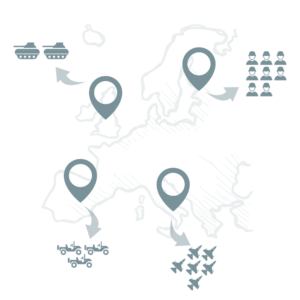Command and Control relies on high-quality logistics and operation data for critical decision making
Military leaders and their staff must make decisions to effectively command and control the diverse capabilities of a joint or multinational force in complex environments. The US Department of Defense Dictionary of Military and Associated Terms defines Command and Control (C2) as:
The exercise of authority and direction by a properly designated commander over assigned and attached forces in the accomplishment of the mission.
During the exercise of this authority and direction, commanders need to make timely and informed decisions. Ultimately, the quality of the decisions strongly depends on the quality of the information that the commander receives as input (situational awareness). To fulfill this mission, information must be current, accurate and contextual. This is possible by enabling data interoperability and workflows from multiple source data systems.
Additionally, commanders need advanced tools to interpret that data and provide situational awareness. These analytics tools, often in the form of maps and dashboards, have intuitive and configurable user interface that can be tailored to the function and staff it supports. These tools are often referred to as Common Operational Picture or COPs.
COP, Logistics COP, RLF
What is a COP?
In Joint Publication 3-0, the US Joint Chiefs of Staff define a Common Operational Picture (COP) as
a single identical display of relevant information shared by more than one command that facilitates collaborative planning and assists all echelons to achieve situational awareness.
This situational awareness is key to making effective decisions despite the fog and friction of operations.
What is a Logistics COP?
A Logistics COP (LCOP or LOG COP), also known as a Recognized Logistics Picture (RLP), is a tool for situational awareness and decision support, specifically for use by logistics personnel. RLP deliver multiple views of equipment, personnel, and supply readiness in greater detail than what is in a Commander’s COP. In an operational context, the RLP allows the logistics staff to optimize available logistics resources in the Joint Operations Area (JOA) and advise or influence the operational commander through the presentation of compelling evidence supported by accurate and timely data.
In an enterprise context, an RLP can be tailored to provide similar visual representations of information to support decisions related to distribution networks, procurements, or positioning of supplies and equipment to support ongoing or emerging operations. Data interoperability is relevant here also, as equipment and materials are typically managed in different information systems based upon which organization manages them, whether they are held in wholesale or retail inventory, or the type of asset (e.g., vehicles, munitions, fuels).
What is an RLF?
A Recognized Logistics Forecast (RLF) does not focus on the current situation but on the future. An RLF uses the current logistic situation (RLP), expected in/out-flows of the JOA, predicted effects of consumption over a defined timeframe, and other related factors to forecast the future logistics situation and resources availability and needs. Using advanced techniques, such as Machine Learning (ML) and Artificial Intelligence (AI), the RLF learns from the past and gives military leaders increasingly accurate predictions of the future situation. An RLF should also be capable of determining the logistics supportability and risks related to multiple operational or enterprise Courses of Action (CoA) to enable logisticians to identify impacts, even second and third order effects from decisions before they are enacted.
These tools are graphically focused products, usually comprised of a mix of geographical and chart-based information, with the ability to interrogate the underlying data when required. They rely on the automated collection, curation, and analysis of data to respond to proposed Maneuver or Logistics COA.

RLP for Multinational Logistics
The JEDI Multinational Logistics Common Operational Picture (MNLOGCOP) is designed to:
- leverage and synchronize data from multiple operational systems
- support multinational data and exercises
- natively compatible with NATO LOGFAS data
- be fully customizable to a user, nation, commodity, operation, or timeframe
- compute metrics or train ML/AI models to provide advanced logistics forecasts
The JEDI MNLOGCOP is a customizable display of relevant information from one or more Command and Nation. Built to natively support LOGFAS, it facilitates collaborative planning to achieve situational awareness, even in multinational environments.
The JEDI MNLOGCOP leverages JEDI-X to integrate and consume data from multiple disparate sources to support even the most complex scenarios. JEDI-X provides structured data to COPs, RLP or to enable an RLF through application of the ML/AI tools that are best suited for the context of the decisions.
Nexus LCM is working with the US Army to implement the JEDI MNLOGCOP capability as an RLP in the Joint Warfighting Assessment series as an enabler for LOGFAS to support embedded multinational Brigades in US Army Divisions